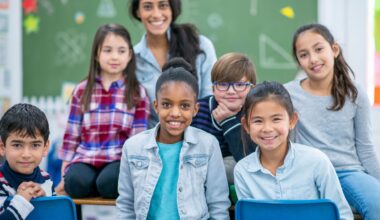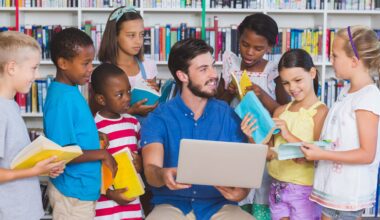Inclusive education is more than just making schools accessible. It’s about creating learning environments where every student—regardless of background, identity, or ability—feels seen, heard, and supported. At the heart of this approach lies Social Emotional Learning (SEL), a framework that helps students build critical life skills like self-awareness, empathy, and responsible decision-making.
In this blog post, we’ll explore the principles of inclusive education, its history, common challenges, and practical strategies for implementation—through the lens of SEL. We’ll also look at how inclusive policies, teacher training, and emerging technologies are shaping the future of education.
What Is Inclusive Education?
Inclusive education ensures that all students, regardless of their physical, intellectual, social, emotional, linguistic, or other conditions, learn together in the same classrooms and schools. It’s based on the belief that every child has the right to a high-quality education that meets their unique needs and that diversity is a strength—not a challenge.
Inclusive classrooms emphasize:
- Equity over equality: Not every student needs the same support, but every student deserves the support they need.
- Belonging: All students should feel they are part of a community.
- Respect for diversity: Differences in learning styles, cultures, and identities are embraced.
The Role of SEL in Inclusive Education
Social Emotional Learning plays a key role in building inclusive classrooms. SEL teaches students how to:
- Understand and manage their emotions (self-awareness, self-management)
- Show empathy and respect for others (social awareness)
- Make responsible choices (responsible decision-making)
- Build healthy relationships (relationship skills)
These skills create a classroom climate where students support one another, resolve conflicts peacefully, and value each other’s differences—making inclusion not just possible, but powerful.
A Brief History of Inclusive Education
Modern inclusive education has roots in the U.S. civil rights movement. Key milestones include:
- 1975: The Education for All Handicapped Children Act guarantees free public education for students with disabilities.
- 1990s–2000s: The Individuals with Disabilities Education Act (IDEA) builds on this, requiring schools to educate students in the “least restrictive environment.”
- Present: The definition of inclusion has broadened to include students from diverse racial, linguistic, gender, and socioeconomic backgrounds.
Inclusion today means creating classrooms where every child—regardless of identity or need—has access to meaningful learning experiences.
Challenges and Misconceptions
Despite the benefits, implementing inclusive education isn’t always easy.
Common Challenges:
- Time and resource constraints: Teachers often lack the planning time or materials to differentiate instruction.
- Limited training: Many educators have not received training on inclusive practices or trauma-informed care.
- Systemic barriers: School structures may not support collaboration between general and special education staff.
Misconceptions:
- “Inclusion only benefits students with disabilities.”
False. Inclusive classrooms benefit all students by promoting empathy, teamwork, and cultural awareness. - “Inclusion lowers academic standards.”
Not true. With the right support, inclusive classrooms can raise outcomes for everyone.
The Bowling Analogy: A Lesson in Strategy
Educator Shelley Moore famously compares teaching to bowling. In a typical game, most players aim for the middle pins. But professional bowlers aim for the edges to knock down every pin—including the tricky ones.
In classrooms, those edge pins represent students with the greatest needs. When we design lessons for those students, we often create better experiences for everyone. This “design for the margins” approach is what inclusive education is all about.
How to Implement Inclusive Education with SEL
Here are practical strategies to support inclusion and SEL in your classroom:
- Use Universal Design for Learning (UDL): Design lessons that offer multiple ways for students to access content and demonstrate understanding.
- Practice differentiated instruction: Tailor content, process, and products based on students’ readiness, interests, and learning profiles.
- Create a safe classroom climate: Use SEL practices like morning meetings, emotion check-ins, and relationship-building activities.
- Adopt flexible assessment methods: Allow students to show learning through essays, presentations, videos, or hands-on projects.
- Encourage peer support: Build opportunities for students to collaborate, tutor one another, and work in diverse groups.
- Leverage assistive technology: Use tools like text-to-speech software, visual schedules, and adapted keyboards to support access.
Training and Support for Teachers
Teachers are key to creating inclusive classrooms. But they can’t do it alone.
What Helps:
- Ongoing professional development: Focused on SEL, UDL, neurodiversity, and trauma-informed teaching.
- Mentorship programs: Pairing new teachers with experienced ones to share strategies and encouragement.
- Access to specialists: Collaboration with counselors, psychologists, and speech therapists helps meet diverse needs.
When teachers feel confident and supported, they can build classrooms that support every student’s growth.
Involving Families and Communities
Inclusion doesn’t stop at the classroom door.
- Engage parents: Invite them to contribute to learning goals, volunteer, and attend events.
- Partner with local organizations: Libraries, youth centers, and nonprofits can extend learning and support outside of school.
- Promote cultural celebrations: Celebrate the different languages, traditions, and holidays represented in your school community.
Inclusive education thrives when families and communities work together with schools.
Future Trends in Inclusion and SEL
The future of inclusive education is being shaped by several exciting trends:
- Recognition of neurodiversity: Embracing conditions like autism, ADHD, and dyslexia as natural variations of human experience.
- Growth of SEL: States are adding SEL standards to guide teaching at every grade level.
- AI and personalized learning: Tools that adapt instruction to students’ unique pace and learning styles.
- Virtual and augmented reality: Making abstract concepts more accessible and engaging.
As these innovations grow, SEL and inclusive education will remain central to helping students succeed in both school and life.
Final Thoughts
Inclusive education is not just a practice—it’s a mindset. It asks us to rethink how we define success, how we support one another, and how we create environments where everyone can learn.
By integrating SEL into inclusive practices, schools can cultivate empathy, equity, and empowerment. It’s not about fixing students—it’s about fixing systems so all students can thrive.
Now more than ever, our schools must reflect the values we want in our society: compassion, inclusion, and opportunity for all.



